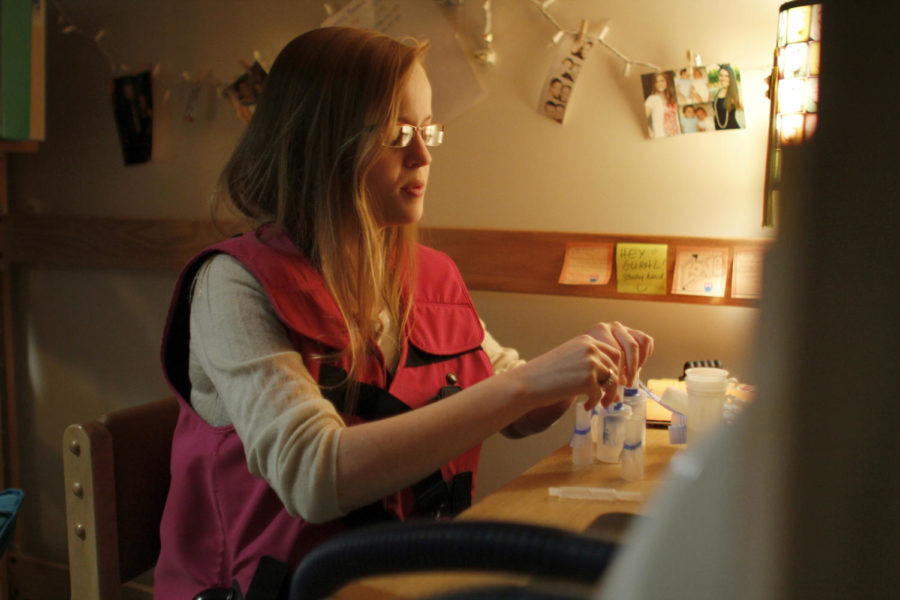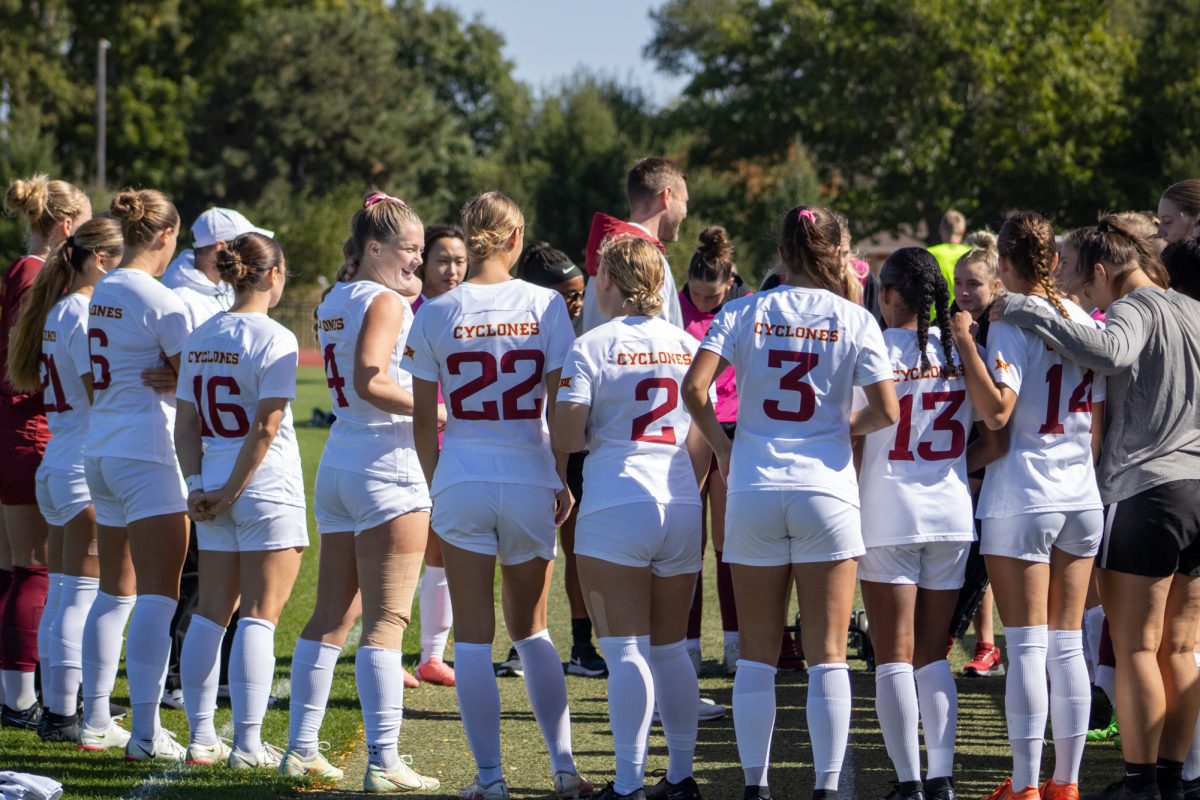ISU student manages daily life while juggling genetic disease and working toward degree
November 14, 2014
Andrea Rider doesn’t think about the life-threatening sticky mucus that clogs her lungs and shuts down her pancreas.
She doesn’t think about the fatal genetic mutation that makes her feel as if elephants are stepping on her chest, causing her to feel as if she’s breathing through a straw.
She has other things to worry about.
Like many other students, Andrea, freshman in meteorology, worries about chemistry exams, group presentations and applying for scholarships.
But she also has to keep up with her Cystic Fibrosis treatments.
Cystic Fibrosis is a life-threatening, genetic disease that primarily affects the lungs and digestive system. The genetic mutation causes a buildup of thick mucus in the lungs, pancreas and other organs, which keeps those organs from functioning properly.
The result is malnutrition, poor growth, frequent respiratory infections, breathing difficulties and eventually permanent lung damage, according to the Centers for Disease Control and Prevention.
Andrea was diagnosed when she was 4 years old. People with Cystic Fibrosis are born with the disease, but Andrea’s doctors didn’t catch it.
“My mom and my dad knew something that wasn’t right,” she said. “I was really pale, super skinny, like a skeleton.”
Her parents took her to a specialist in Des Moines who performed a sweat test, which measures the amount of salt in a person’s sweat, to check for a high level of chloride.
At the time, Susie Rider, Andrea’s mother, didn’t know that’s what the sweat test was for.
“[The doctor] saw enough of things to call and do some testings that were specifically CF related, but he didn’t tell me that’s what he was doing that for,” Susie said. “I think part of it was probably not to have me start Googling it and getting all worked up about it.”
Then the results came back positive for Cystic Fibrosis.
“Our world came crashing down,” Susie said. “She was so little. They told us six more months undiagnosed, we probably would’ve lost her. It was very hard to hear.”
The average life expectancy for those diagnosed with Cystic Fibrosis is in the early 40s, according to the Cystic Fibrosis Foundation. Lung disease is the usual cause of death in most patients.
“I remember being with them when they found out,” Andrea said of that day in the hospital. “I remember my parents crying. I was just sitting there playing with my toys.”
Susie and Jeff chose not to tell their 4-year-old first-born because she was too young to understand.
But Susie remembers the day her daughter asked if the disease was going to kill her.
Andrea had taken the book “Taking Cystic Fibrosis to School” to show the school nurse the day when she asked her mother that dreaded question.
“I had forgotten there was an FAQ section and in there one of the questions was ‘Is Cystic Fibrosis fatal?’” Susie said. “It talks about yeah, it is and why. I picked her up from school and like every day I asked her how her day was. She goes, ‘mom, I found out today that CF can kill me’.”
So Susie had that dreaded conversation with her 8-year-old daughter about how the mucus buildup in her organs will clog her airway, leading to severe problems with breathing and cause bacterial infections in the lungs.
“I cried and she hid in the pillow,” Susie said as she recalled that day. “She hated seeing me cry.”
Andrea’s younger brother, David, also had a hard time finding out about the disease’s effects.
“When he learned about the life expectancy, that bothered him a lot,” Andrea said. “When I see him upset, it bothers me too. He’s my baby bro, I don’t want him to be upset about it.”
But Andrea tries to keep things positive.
“I actually don’t think about it much,” she said. “I’m doing well. I feel like I’ll have longer.”
Andrea keeps up on her daily care regimen and she thinks that’s a tribute as to why she’s a healthy CF-er.
Her daily care regimen consists of:
- two to four vest treatments – a vest she wraps around her that inflates and vibrates her whole body to shake the mucus loose from her lungs
- nebulizer medication – inhaling a sterile saltwater mist
- seven to 10 vitamins and pills twice
- insulin injections and blood sugar checks
- three pills with every meal
She also makes a clinic visit once every three months for four-hour appointments. She sees separate doctors for her lungs, pancreas, diabetes and nutritional health.
Elaine Waldschmitt, registered dietician with United Point Health Des Moines, has worked with Andrea and the Rider family for the past 15 years and said Andrea’s consistency in doing her treatments has helped to keep her healthy.
“She is very compliant. She has always stuck with [the treatments],” Waldschmitt said. “She’s very positive. We love her here. We love her whole family.”
The whole Rider family focuses on keeping that positive attitude, living in the moment and stomping out Cystic Fibrosis.
The Riders started a fundraising group called Andrea’s Angels that holds fundraising events throughout the year to give to the Cystic Fibrosis Foundation. The foundation puts the money toward creating quicker, easier, more effective treatments for people with Cystic Fibrosis.
The team’s latest fundraising effort is a Bolder Band, Andrea’s Band, which can be purchased for $15, with part of the proceeds going to the Cystic Fibrosis Foundation.
Back in high school, Andrea played the flute and ran cross country. The flute was considered a treatment for her when she was younger because of all the air and chest movement needed to play the instrument.
Andrea took her accomplishments from high school and used them to help her win the $22,000 AbbVie CF Thriving Undergraduate Scholarship – a national scholarship dedicated to helping students with Cystic Fibrosis further their education.
Andrea and more than 200 other students with Cystic Fibrosis from around the country wrote an essay, listed key high school accomplishments and submitted an art piece to make it past the first round. Andrea and 39 others made it past the first round to receive $2,500.
The second phase was a month-long voting phase, where Andrea had to campaign for her cause.
“I went to the mall in Des Moines and I put fliers on all of the cars,” Andrea said laughing. “I Facebooked, Snapchatted, Instagram, all of those.”
When she found out she had won the scholarship, Andrea said she was ecstatic and is thankful for the support.
“Without all those votes, I wouldn’t have gotten it,” she said. “Whenever people ask me if I got the scholarship, I tell them yes and give them a hug because they were a part of that.”
Andrea has put her scholarship to use thus far at Iowa State and keeps herself busy with homework, extracurricular activities and spending time with her roommate, a friend from high school, Sydney Allen.
Allen, freshman in earth science, met Andrea in the second grade. She didn’t know Andrea had Cystic Fibrosis until she wanted to invite her over for a sleepover.
“Her mom told me she couldn’t sleep over because she had to do her treatments,” Allen said.
When the girls were in the fourth or fifth grade, Allen wanted to raise money for the Cystic Fibrosis Foundation. So she held a mini carnival fundraiser for Andrea’s Angels in her backyard and ended up raising almost $500.
Allen, too, found it difficult to discover Cystic Fibrosis was fatal.
“I didn’t want to believe it,” she said. “The more I got to know Andrea, the more her mom explained how it was fatal. It’s good to know [Andrea is] a healthy CF-er so her life expectancy is longer, but it was definitely a shocking thing to hear.”
The girls don’t let the thought bog down or change the way they’d spend their freshman year of college, though, and find fun things to do on the weekends.
But Andrea still has to remember to do her treatment before she goes anywhere.
She may have to ask people to wait an extra half an hour to leave for an activity or explain why she has to take three pills every time she eats a meal, but Andrea doesn’t let that stop her.
Andrea doesn’t think about the monthly prescriptions, inhalers, the four-hour long doctor visits every three months or a life expectancy. She and her family focus on raising awareness for the cause and spending time together.
“We’re not going to keep living life always thinking about death,” Susie said. “We’re going to think about living. We’re going to live in the now, do what we need to do and keep going and we’ll take things as they come.”







